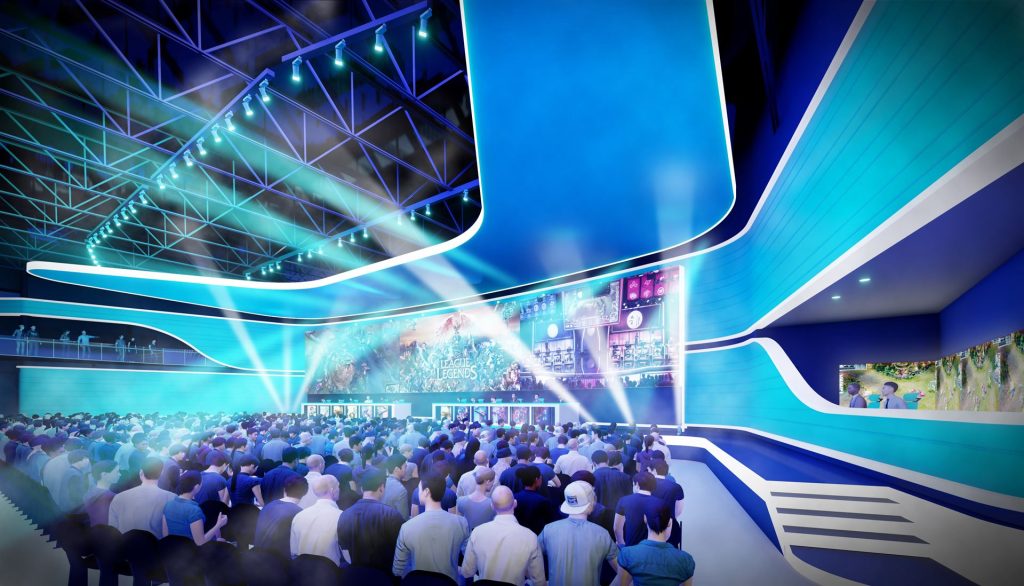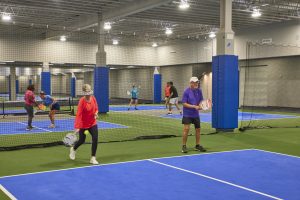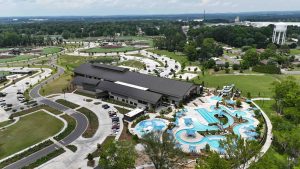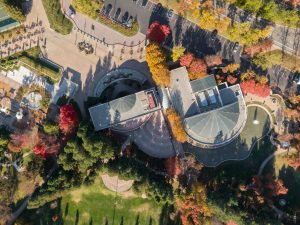Guest post written by Johnny Crosskey, SEO & Content Specialist, The Sports Facilities Companies.
While esports is quickly becoming a part of mainstream entertainment, its origins date back to 1962 when students at the Massachusetts Institute of Technology developed “Spacewar!”, one of the first games to feature a video display. Ten years later, this game became the centerpiece for the world’s first esports tournament, the “Intergalactic Spacewar Olympics”, held at Stanford University.
Download our Cedar Point Sports Center Case Study
From those humble, niche beginnings, the desire for bragging rights pushed pioneering developers to advance ground- breaking technologies, new streaming platforms, and unparalleled visual experiences.
In 1979, Atari developed the game Asteroids and included a high score list to memorialize top performers on the game. For the first time, gamers were able to compare their abilities with others around the world. This led Atari to introduce the Space Invaders Championships in 1980. This was the first national esports championship and included 10,000 participants. Legendary gaming console maker Nintendo followed suit in 1990 with its own Nintendo World Champions. Players competed in “Super Mario Bros”, “Rad Racer”, and “Tetris”, a popular trio of games during that period.
In the 1990s, competitive gaming also became integrated with the emergence of personal computers, private internet connections and advanced networks, all of which saw dramatic growth in their technological capabilities during this time. This allowed players in different locations to play against each other, which not only made larger competitions possible, but it also allowed for smaller groups of people to connect, build their skills, and compete. This led to the first group of gaming clubs known as clans. Over time, the clans began to compete against each other in tournaments, becoming the precursor to today’s esports teams and leagues.
In the late 1990’s, esports continued to grow steadily, both in the U.S. and throughout the world. It became particularly popular in South Korea where events such as the World Cyber Games were not only becoming popular among gamers, but were also growing a spectator audience on local television.
Television became a vehicle for driving viewership, which led to sharp increases in sponsorship revenues for the sport. Tournaments became larger and more lucrative, including the Worldwide Webgames Championship, one of the first to offer $1 million prizes.
While these are all key points in the esports story, it’s the emergence of social media, especially the platform Twitch, that allowed it to ascend to the heights we see today. Twitch is an online broadcasting platform that allows global fans to not only watch esports performers but interact with them as well. This led to the meteoric growth in the popularity of professional leagues such as Overwatch (OWL), Call of Duty (CDL), and League of Legends, and spawned a new generation of professional and recreational gamers.
According to Statista, 474 million people tuned in to watch esports in 2021. This audience is expected to grow to 920.3 million viewers by 2024. Globally, esports has an estimated value of $947.1 million in 2020. The number is expected to climb to $3.5 billion by 2025. This growth has caught the attention of facility developers and led them to create venues to meet the demand. While many point to major esports- specific venues like eSports Stadium in Arlington, TX as an example of this trend, smaller venues and facilities that are “esports-ready” are being built as well. Also, structures such as box stores, movie theaters, and gyms are being retrofitted into esports facilities.
How It Works:
Having an esports component in your facility starts with planning. Venue developers and owners must first consider the type of programming they want to conduct in their facility. While we all know about the venues that host large tournaments or professional leagues, there’s also an emerging group of “drop in and play” esports areas in sports and entertainment facilities that allow guests to play games casually while family members compete at tournaments. Typically, these areas are small (under 25 gaming stations) and are built to hosts birthday parties, camps, and youth leagues.
Overall, facilities must have the technical infrastructure to support esports play. Primarily, the two biggest factors are having the proper amount of power and connectivity, one of the biggest challenges venues face is providing connectivity with little to no latency (the time it takes for data to travel out to a specific point and back). Gaming devices (computers or consoles) perform at a slower speed when this time interval is too long. Lag time, as it is known, is greatly reduced when venues use wired connections to connect the devices directly into a central network versus using a Wi- Fi connection. While these “hardwire connections” create a more reliable environment for gamers, the costs are much higher to incorporate into the infrastructure of a new facility development. Additionally, this infrastructure is dedicated to other equipment in the facility making it challenging to find room for more connections to facilitate esports.
Technical Setup:
In terms of the technical setup, your esports venue will have an IT closet, also known as a Main Distribution Frame (MDF). This area connects telecommunications lines entering the facility with its internal network or server. The MDF connects to an Independent Distribution Frame (IDF), a device that connects servers to a set of end points such as gaming terminals. These terminals, whether computers or gaming consoles, are connected to the IDF via cat- 5 or cat-6 ethernet wires. It’s this connection that allows gamers to compete with one another, communicate with teammates, and for the whole thing to be streamed on a variety of platforms with little to no lag taking place. Because it’s critical that the wiring coming from IDF and MDF areas is placed where esports events or activities are taking place, there is a 300 linear-foot limitation on wiring runs before additional before additional infrastructure is required to boost the signal.
In terms of power, venues with esports components, must have an abundance of energy, electrical outlets, and wiring to support the number of stations in the gaming area. Regardless of venue size, it’s standard to have 120V 20-amp service per station along with the necessary accessories.
Converting an Existing Space:
To convert an existing space in a venue to an esports space without a technical infrastructure investment, there are a few items to consider. From a technical standpoint, if the space is not located near your IT closet or MDF, a remote networking hub can be used. This is small unit that can receive a fiber patch (wiring) from the MDF and distribute cat-5 or cat-6 wiring to gaming stations. The remote networking hub is often used to supplement the number of connection ports provided by the IDF. In this setup, wires can be hidden with ramps.
In converting a space to support esports, the most important question to ask in terms of power is if it can currently support trade shows. If your space does, you’re in luck. Trade show power requirements are similar to what’s needed for esports spaces. In some conversions, spider box units are used to lessen the need for lengthy cords throughout the space and allow the main power and infrastructure to be split up and supplied to multiple stations.
Venue connectivity is determined by the amount of fiber wiring and connections that need to be built into a facility to support the computers and gaming consoles outlined in the program plan.
Facility Design:
In terms of the physical space, there are several features to consider depending on whether you are building a large tournament venue or one designed for “drop in” or recreational use. For smaller venues, esports spaces should be built to feel like a community gathering space. When placed in larger sports and event facilities, esports spaces are often placed away from high trafficked areas and supported by clear wayfinding. These areas typically feature TVs and soft seating as well as gaming stations with lighted keyboards and other experiential design aspects. Additionally, these areas are near food and beverage areas.
Larger esports venues may include playing areas, stages, monitors allowing guests to watch game action, a production room for streaming broadcasts, and separate team rooms for smaller events and practices. Some facilities also have a player’s lounge.
Competitive Structure of Esports:
The competitive structure of esports differs from that of traditional sports. While there are organizations that develop events, promote competition, and advocate for the sport, there’s no governing body to develop and enforce policy for esports in the way that, for example, the NBA does for American professional basketball. Instead, competitive play (professional leagues and tournaments) centers around the games themselves and is organized by game developers. They are the ones that govern leagues, enforce rules, and crown champions.






